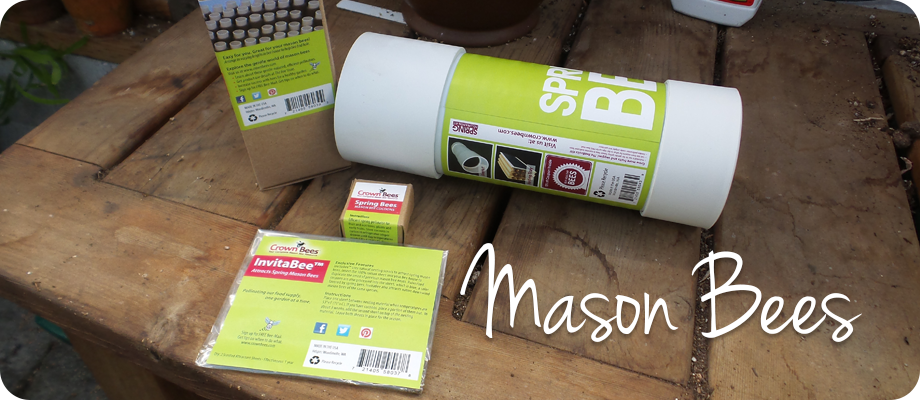
by Susan | Mar 15, 2015 | LB Tutorial: Garden Critters
Back in February we wrote about Mason Bees and the tremendous job they do pollinating the garden. With our warm weather starting early this year I purchased my kit from my local nursery, Valley Nursery, two weeks ago. The guidelines say to wait until it is 53 degrees and warming in the daytime. It has been getting up to 58 – 59 in the daytime and yesterday was even warmer so I’m going to put my bees out.
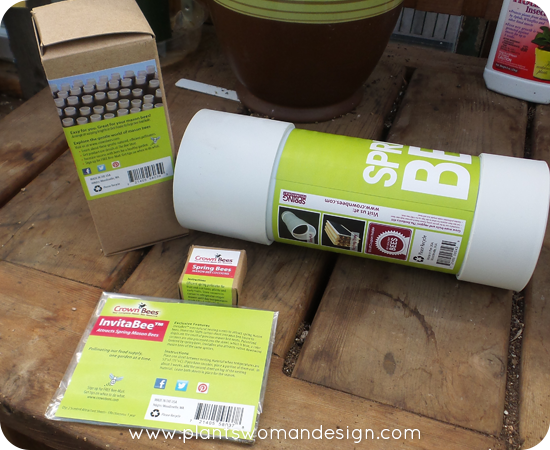 This is the Crown Bee Kit I purchased. The bees come separate so you can get more If needed. I had a hard time deciding where to put the nesting box. It needed to be where the sun would hit it early in the day to warm them, not near predators (birds mostly), and within 300 feet of a mud/water source. Wanting to see them in action I placed it on a post at eye level next to my vegetable garden plot behind the green house. Mason bees need a ready food source (something blooming) when they emerge. The espaliered fruit trees are almost ready to bloom so they will be available for early food for the bees along with the Forsythia, hellebores, and Indian plum (oemleria cerasiformis) blooming now.
This is the Crown Bee Kit I purchased. The bees come separate so you can get more If needed. I had a hard time deciding where to put the nesting box. It needed to be where the sun would hit it early in the day to warm them, not near predators (birds mostly), and within 300 feet of a mud/water source. Wanting to see them in action I placed it on a post at eye level next to my vegetable garden plot behind the green house. Mason bees need a ready food source (something blooming) when they emerge. The espaliered fruit trees are almost ready to bloom so they will be available for early food for the bees along with the Forsythia, hellebores, and Indian plum (oemleria cerasiformis) blooming now.
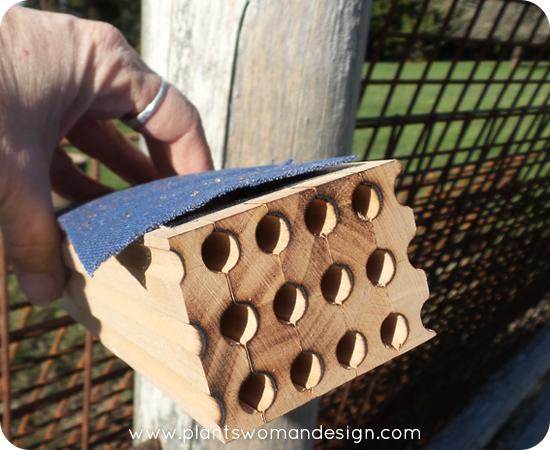 Following the directions, I placed the lid on the post and used screws to attach it. I left the top screw out a little and tightened the bottom one so there was a little slant. This helps to protect the home from rain. However, the downward slant can’t be too great or the block of nesting holes will fall out.When the tube was attached , I took off the clear plastic cover, slid the block inside and put the bee attractant, which helps the bees find their home when they first emerge, on the top.
Following the directions, I placed the lid on the post and used screws to attach it. I left the top screw out a little and tightened the bottom one so there was a little slant. This helps to protect the home from rain. However, the downward slant can’t be too great or the block of nesting holes will fall out.When the tube was attached , I took off the clear plastic cover, slid the block inside and put the bee attractant, which helps the bees find their home when they first emerge, on the top.
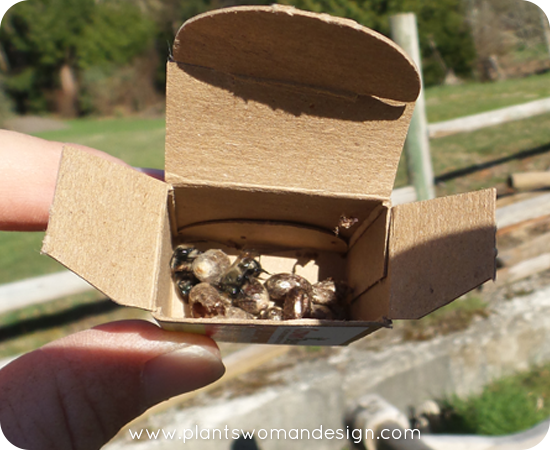 When I opened the box of bees, it was so exciting to see that a couple of the bees had already emerged from their cocoon! I could see them sleeping in there.
When I opened the box of bees, it was so exciting to see that a couple of the bees had already emerged from their cocoon! I could see them sleeping in there.
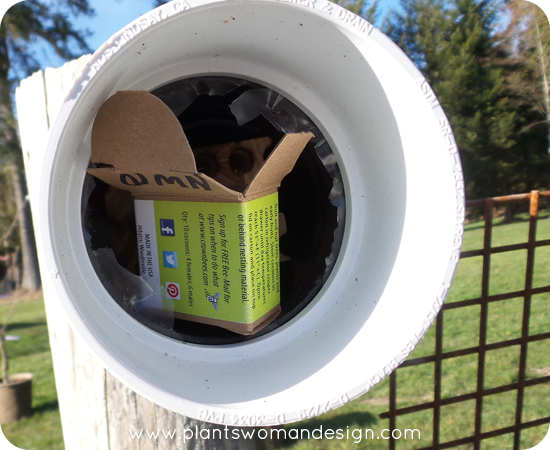 I placed the box near the opening so as they emerged they would see the nesting box. When I checked the next day I saw two bees flying around the box.
I placed the box near the opening so as they emerged they would see the nesting box. When I checked the next day I saw two bees flying around the box.
I want to build another box this weekend and try out the straws I bought. Straws are an alternative nesting material for mason bees that are disposable. When the season is over, the straws are taken apart to harvest the bee cocoons. The box I have now can be taken apart and cleaned after harvesting the new bee cocoons. The instructions recommend taking the cocoons out in the fall and storing them inside a refrigerator or cold shed until spring arrives to start the process again. Removing the cocoons and storing them protects them from predators in the winter.
Are you jumping into Mason Bees with us? We want to hear about it! Leave a comment below or follow us on Facebook.
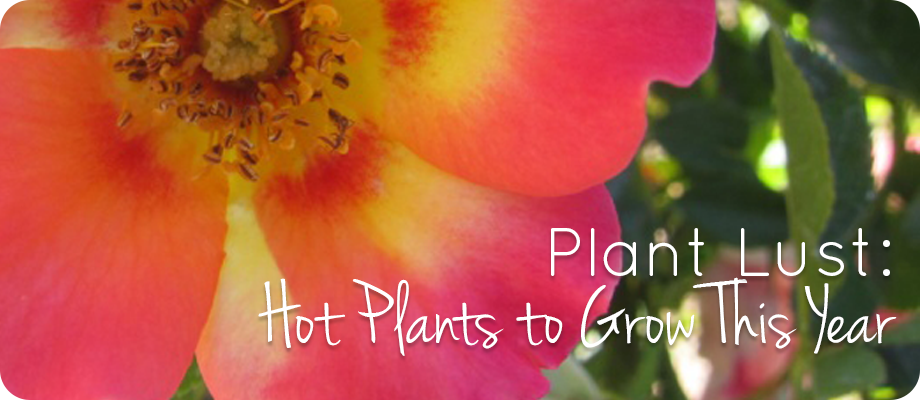
by Susan | Mar 6, 2015 | plants
Every year I read up on the new and hot plants for the year. It is fun to keep up with the new arrivals and even things that are making a comeback.
Here are a couple of my ‘want to try’ plants this year.
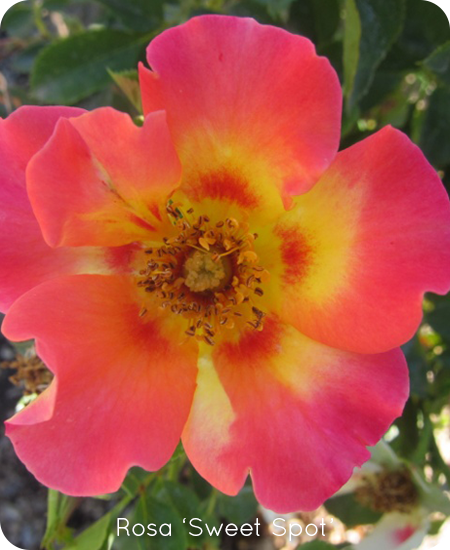
photo from www.monrovia.com
The Calypso Rose, Rosa ‘Sweet Spot’
It is a nice compact rose 2 feet tall with shrubby form. Works great in containers or as a blooming border. Great array of colors from pinkish red and yellow with stunning dark eyes changing throughout the season. Reminds me of the China rose I have planted in several client’s garden’s to rave reviews. This one is a little easier to care for and will stay smaller. Zones 5 -10 and available from Monrovia this year.
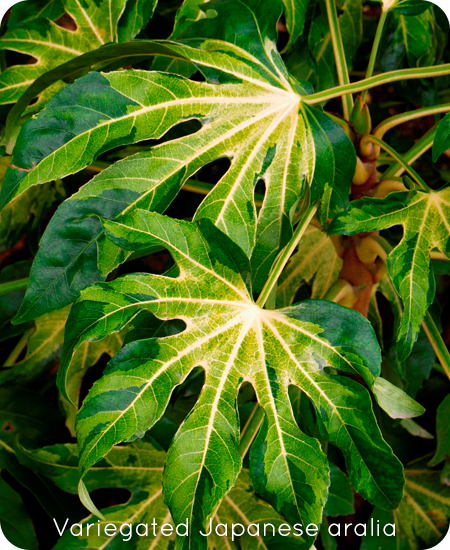
photo from www.monrovia.com
Fatsia Japonica ‘Variegata’ Camouflage / Variegated Japanese aralia
I purchased several of these last year and have to say I still love them. The leaves are VARIEGATED in an amazing way. It is lush and exotic with lovely fat leaves giving a tropical feel in our zone. I’m always looking for that crazy fat leaf and this one just makes me want more! Zones 7-10. A Dan Hinkley introduction through Monrovia.
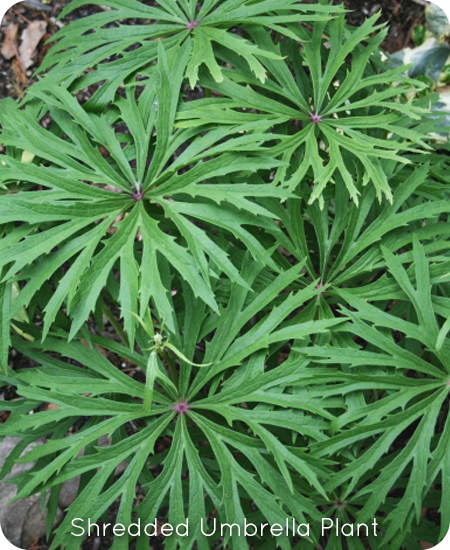
photo from www.plantdelights.com
Syneilesis aconitifolia – Shredded umbrella plant.
Speaking of tropical. Here is another woodland plant that has that tropical feel. It loves the shade and grows to about 18 inches in height. Jumps out of the ground in spring with wooly new leaves. The foliage looks great with helebores, hostas, epimediums and gingers. Zones 3a – 8b. Available from Plant Delights Mail order.
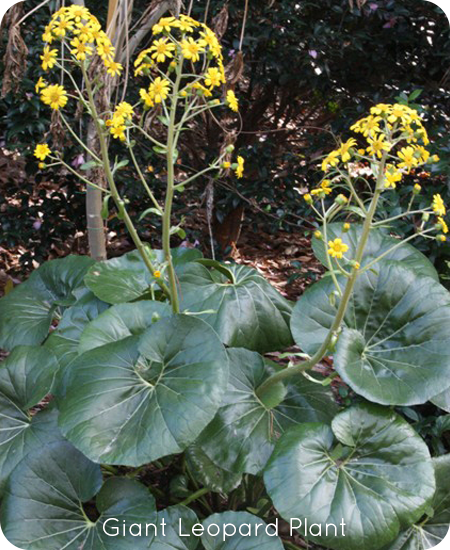
photo from www.plantdelights.com
Farfugium Japonicum ‘Giganteum’ Giant Leopard Plant
OK one more. This moisture loving perennial has great glossy leaves that emerge in early spring. The rounded leaves are abundant and lush with a yellow flower later in the year. The foliage alone is enough for me. I have grown the ‘leapordi’ one before (spots on the leaves) and it was hardy. I’m anxious to try this one too, hardy to zones 7 – 10 . I should be able to find in locally at a nursery in Seattle, also available at Plant Delights.
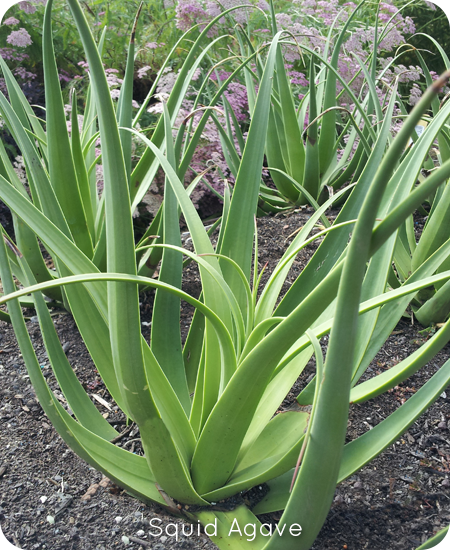
photo from www.monrovia.com
Agave bracteosa ‘Calamar’ – Squid Agave
Since the siding on my new house is stucco and has a southwest flair that just calls for agave. This one is without spines! It also looks like a squid! Crazy right? It’s green and white striped leaves will reach up to 4 feet tall and 3 feet wide with age Hardy to Zone 7B – 11. Good drainage is important with no standing water. Available through Monrovia.
Cornus kousa var. chinensis ‘Madi-II Mandarin Jewel’
Can’t leave out trees. This one looks so amazing I am on the hunt. It has a traditional Dogwood look with abundant white flowers. but when the fruits ripen they are a delicious light orange instead of traditional red. They persist into the fall when the leaves turn yellow-orange. Sounds to be a striking, yell out loud, fall beacon. Zones 6 – 9. You should be able to find this at your local nursery.
Of course there are always more that I want to try but I have to stop somewhere. I’d love to hear what you’ve got your eye on this year? Simple or exotic, I want to hear about it!
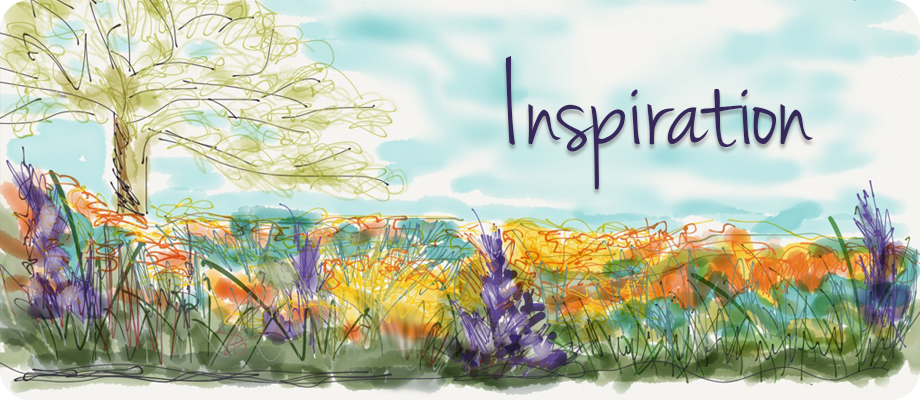
by Susan | Feb 27, 2015 | garden travel
The sky was beautiful last night. First raspberry, changing into soft orange then fire red. I just wait, keep waiting… Bruised purple with dark gray tips. February is not usually this kind to us. As I look at the beautiful sky I think about the garden. I think about the soft oranges and yellows of spring. Primroses in colors of the sunset with the still dark gray of decayed birch leaves behind. Why do I think of the garden when I see the sky?
It is what inspires me.
Here are other things that inspire me right now.
- New vegetable seeds with amazing contrasting leaves. Purple carrots, Black tomatoes, Rainbow chard, and even white tomatoes.
- Planting a hedgerow with native plants mixed with fruits and early bloomers for bees.
- Hellebores and ferns competing to see which curled shoot can beat the other one to the sun.
- Tibochiana and clivia blooming in the greenhouse reminding me of coming spring.
- An amazing meadow with one piece of art surronded by an ever changing tapestry of plantings.
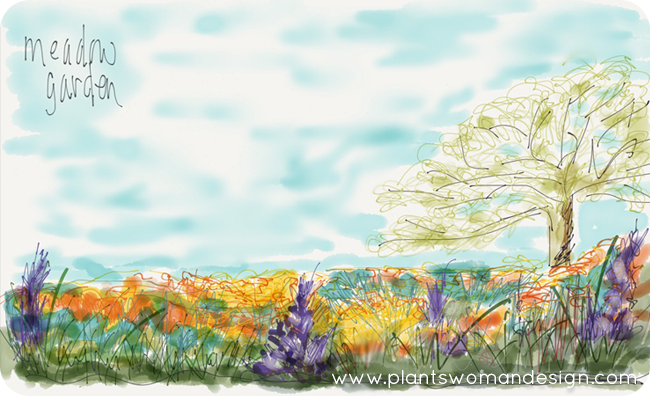
my own meadow garden musings…
A beautiful meadow planting by Adam Woodruff was featured in Fine Gardening Magazine’s February edition. You can take a look at the plant list of this amazing garden HERE.
- A childs garden with a muddy frog pond, log stump steps and maze through grasses.
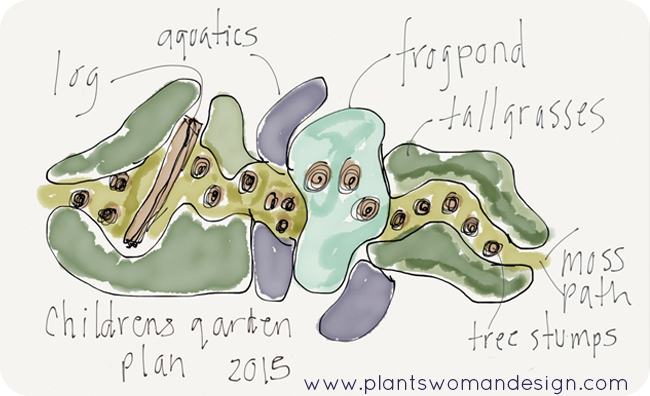
my children’s garden musings…
The Red Butte Botanical Garden in Utah has a great children’s garden. Even in the winter time there was much to see, here’s what I found…
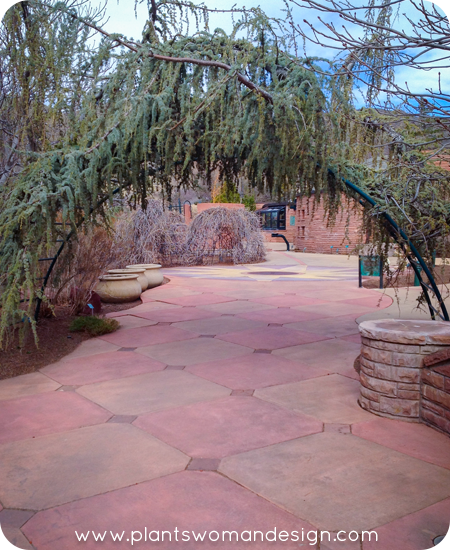
Children’s Garden Entrance
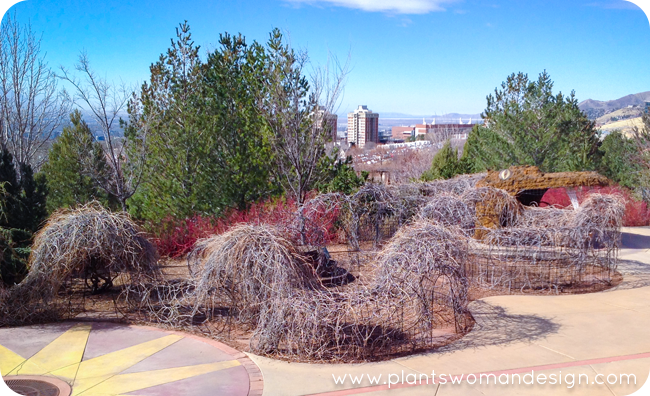
Children’s Garden Snake Maze
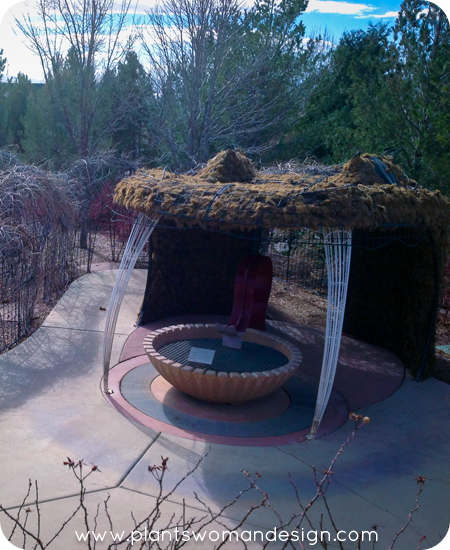
Open wide!!
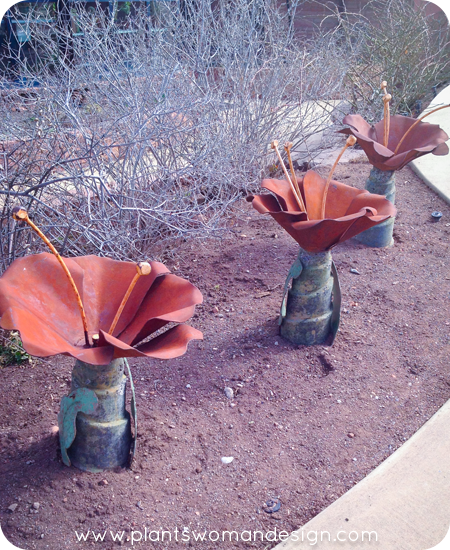
metal flowers
What inspires you? I’m so excited to plan, plant, and enjoy! Let the Gardening begin.
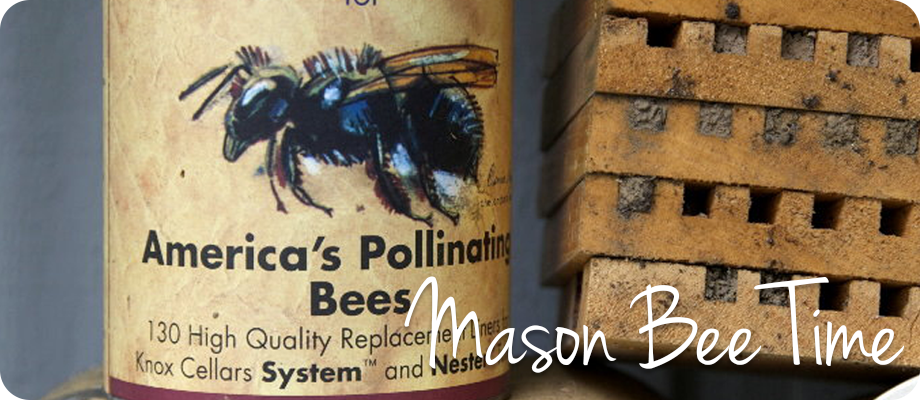
by Susan | Feb 20, 2015 | LB Tutorial: Garden Critters
We have had some beautiful spring days….. Oh, wait a minute, it isn’t spring, it’s only February. I’ve been busy pruning my apple trees (severely) and watching the buds swell. The rest of the nation is covered in white and we are having 60 degrees and sun. No real accumulation of snow in the mountains probably means water shortages in the summer (all part of climate change I think). But I’m getting off track a little.
Mason bees, yes!
Very important pollinators of the fruit trees on my property and surrounding plants. Last fall I said I was going to get bees this spring and I am getting ready to bring them home. When I told Kristen I was getting bees this spring she thought honey bees for honey and wax. But that wasn’t what I was planning on getting. I’m getting Mason Bees. No honey, no wax just fantastic little pollinators that don’t need a lot of vigilant care.
There are a number of bees, called mason bees, that are very good at pollinating fruit trees, so much so that they are also known as orchard bees. Mason bees (members of the genus Osmia) carry pollen on their bellies rather than on their hind legs and they nest in holes. When building their nests, mason bees use clay to make partitions, or cells, for their eggs and to seal the entrance once the hole is full. This unique mud-building behavior leads to their common designation as masons.
Honeybees are very important to commercial agriculture, but native bees like the blue orchard bees are better and more efficient pollinators of native crops. There are 140 species of Osmia in North America. They are all known for visiting fruit trees, such as apples, plums, pears, almonds, and peaches along with any other flowers or veg that is nearby. The blue orchard bee or Osmia lignaria, is prized for its efficiency pollinating fruit trees and is one of the few native pollinators that is managed in agriculture.
Blue orchard bees are about the same size as a honeybee but there are a few key points that help you tell them apart. Blue orchard bees are a dark metallic blue, not striped brown and orange like the honeybee. If you pay attention to where they carry their pollen you can also easily tell apart masons and other leaf cutters from honeybees – honeybees carry round balls of pollen on their hind legs.

Osmia lignaria, the blue orchard bee. (Photo by Scott Famous, bugwood.org.)

Osmia ribifloris, the blueberry bee Photo by Jack Dykinga, bugwood.org
Masons are solitary like most native bees. This means that each one tends to its own brood, instead of having a queen and worker bees. However, they seem to like the company of others of their kind and happily build their nests next to each other. They also readily accept the hollow tubes provided by the orchard grower for this purpose. This proves to be very beneficial to the fruit tree grower because it makes it easy to manage this valuable orchard helper.
We, as home gardeners, also have the opportunity to have some orchard bees in our own gardens by placing hand-made or store-bought bee houses or bee blocks in our yards. These gentle bees rarely sting and if they do it is only in defense. The sting is hardly noticeable like a mosquito bite. Great for getting kids interested in watching pollinators.
The blue orchard bee season is early spring. Once they emerge they promptly mate, search for empty holes that are the right size and shape and go to work stocking their nests. The favorite food for their brood is fruit tree pollen plus some of their nectar. Females collect this food, bring it to their nests, and knead it into a ball, mixing it with nectar and their own saliva. Once they have a food store that is big enough, they lay an egg on top of this mass and seal-off the chamber with a little mud wall and start gathering food for the subsequent cell. They work this way until there are five to eight cells each with food and one egg. Then, they seal the entrance to the hole with a thicker mud wall. The larvae grow and, by the end of summer, metamorphose into pupae and later on into adults, which remain safe and sound inside the nest until the next spring. The new generation emerges the next spring usually in perfect timing with the blooming peach or apple trees.
A quick fact – the first brood cells that the orchard bee makes (those that are furthest back) will develop into female bees, while the ones closer to the entrance of the nest will become males. Scientists believe that bees do this for one of two reasons. Males need to emerge first so that they wait for new females during mating season – putting them closer to the entrance helps them emerge first. Bees also suffer nest predation, and the brood closer to the entrance would be predated first. I think it is interesting that females are much more important to the reproduction of a species than males are. Putting the males as a barrier increases the survival and fitness of the species.
I am picking up my bee houses this weekend and will post about building the houses when I get them finished. My bees will come in later when true spring arrives. In the meantime take a look at the Growing a Greener World episode about Dave Hunter, owner of Crown Bees in Woodinville, and his Mason Bee crusade.
(featured title photo by Thomas Boyd/The Oregonian)
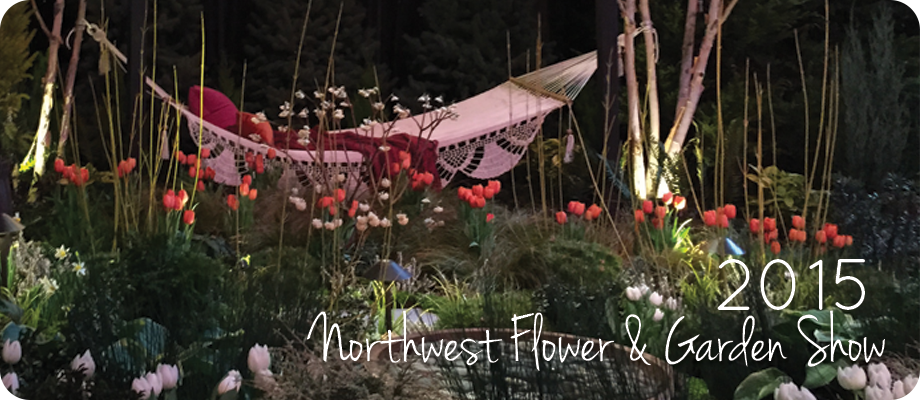
by Susan | Feb 14, 2015 | Plantswoman Design
It is garden show time and while Plantswoman Design didn’t create a display garden we attended the show enjoying our role as observers. We would love to share what we loved with you.
First the gardens…
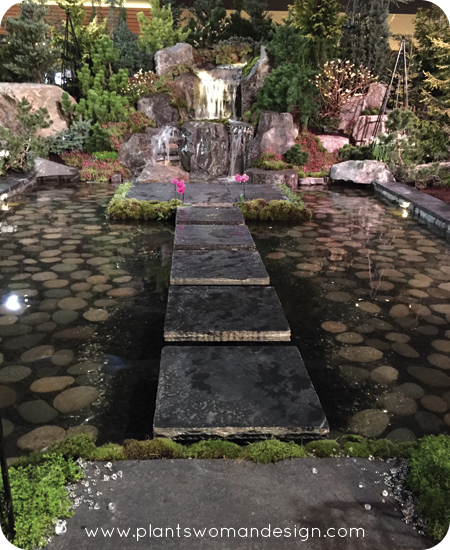
This garden was titled ‘A moment to remember’. Nature Perfect Landscaping did a great job of creating a mystical setting for a wedding. The fabulous water fall in the background with the mountainous rocks made it seem like you were in a grotto in the wilderness. I loved the ‘floating’ platform and steps.
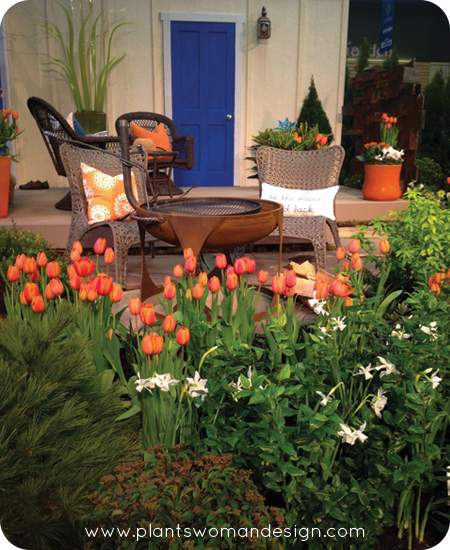
Susan Browne did a fun rendition of ‘Love the Space You’re In’. Love the orange with contrasts of blue. I wanted the chairs. (designer secret Lowes, Thanks Susan Browne).
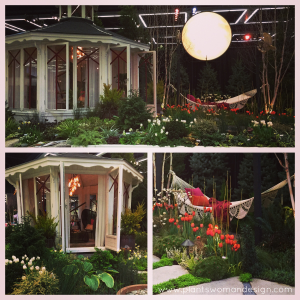
Over the Moon was over the moon and took top honors this year. The restricted palate was great with white and green taking center stage. Susie Thompson did a fabulous job mixing textures and colors of plants with the hardscape elements. A Swedish gazebo was a beautiful touch. Thanks ADLP for this great design and installation.
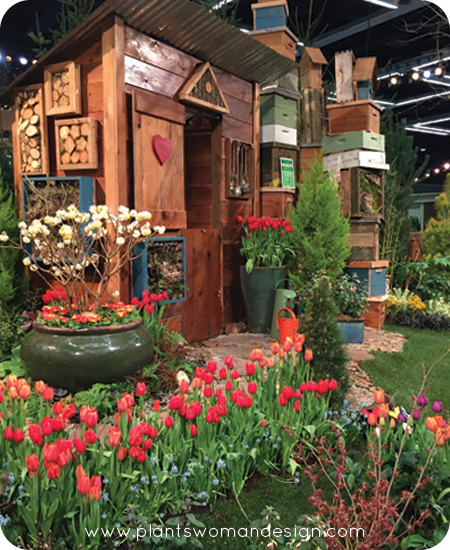
Two Nurseries joined the garden floor this year. West Seattle Nursery had a eclectic and interesting garden with lots of levels for birds and bees. The fun use of wooden bird houses and bee hives with the plants was great. They had a choice peach tree in the front.
The theme this year was “Romance Blossoms”. There was A LOT of PINK. I mean A LOT !!
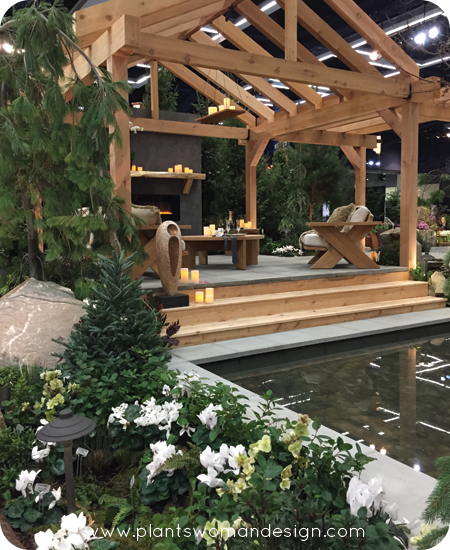
Thank goodness Karen Stefonik ran counter to all the pink at did a masculine take on the theme. Big beams ran across the space and the large scale of the furniture and fireplace made it a place you wanted to hang out in. The reflecting pond gave a quiet soothing view surrounded by the restricted colors of white and green. (designer secret Costco for the fireplace).
What I Missed This Year:
Good Rare and unusual plant nurseries. Our local Plantsman Nils Sundquist was there and Keeping it Green Nursery was there but I was missing Kelly from Far Reaches, and Edelweiss Plants from Oregon. I love the good unusual plants.. Hoping they come back next year.
I missed seeing all my customers and friends as they came to visit my display. It is always fun to have friendly faces in the crowd when you are in a big display garden.
Cyle, the previous show director has moved on to different things. It was sad to see him go last year and I missed his unflappable personality and dry wit. “How bad is it leaking…? That’s ok just mop it up and see how it does.” “The tree house fell down in the middle of the night. I wonder if anyone heard it?”
Edibles. This apparently was not the year of the chicken, goat, or vegetables. Usually we get to enjoy the garden creators tucking in a small veg garden and helping us to remember sustainable landscapes and self-sufficiency of growing our own food.
What Was New:
Family Farm Center – Located in the back hall was an interactive farm for children. It was sponsored by Farmer Frog, the creators of Urban farming programs in the Puget Sound. It was good to learn about the fight to feed the hungry in our area. 1 in four children go to bed hungry in our area each year. Check out their website for ways to learn about the process and ways to help.
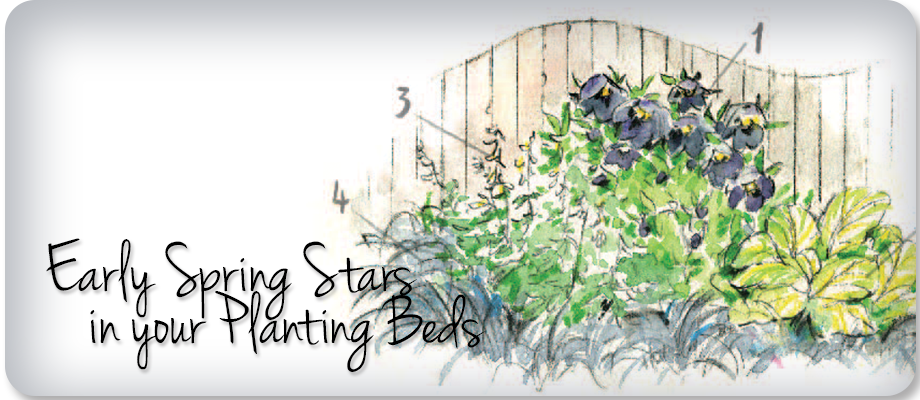
by Susan | Feb 6, 2015 | plants
Today I thought I would share with you a recent article I wrote for Fine Gardening Magazine. The Northwest section of the Regional Picks column is in the April issue and features a plant combination that I put together. It is such an honor to be included in this great magazine and to work with such knowledgeable, wonderful people.
I’m including a copy of the article below but that does not mean you should not go get a copy for yourself. There are several more great articles including plant propagation, grafted tomato trials and a beautiful wooded garden in New York that looks like it could be here! Fine Gardening does a great job of presenting all levels of gardening and most types of gardening. Articles on vegetable gardening, gardening skills, plant trials, and new plants are always featured.
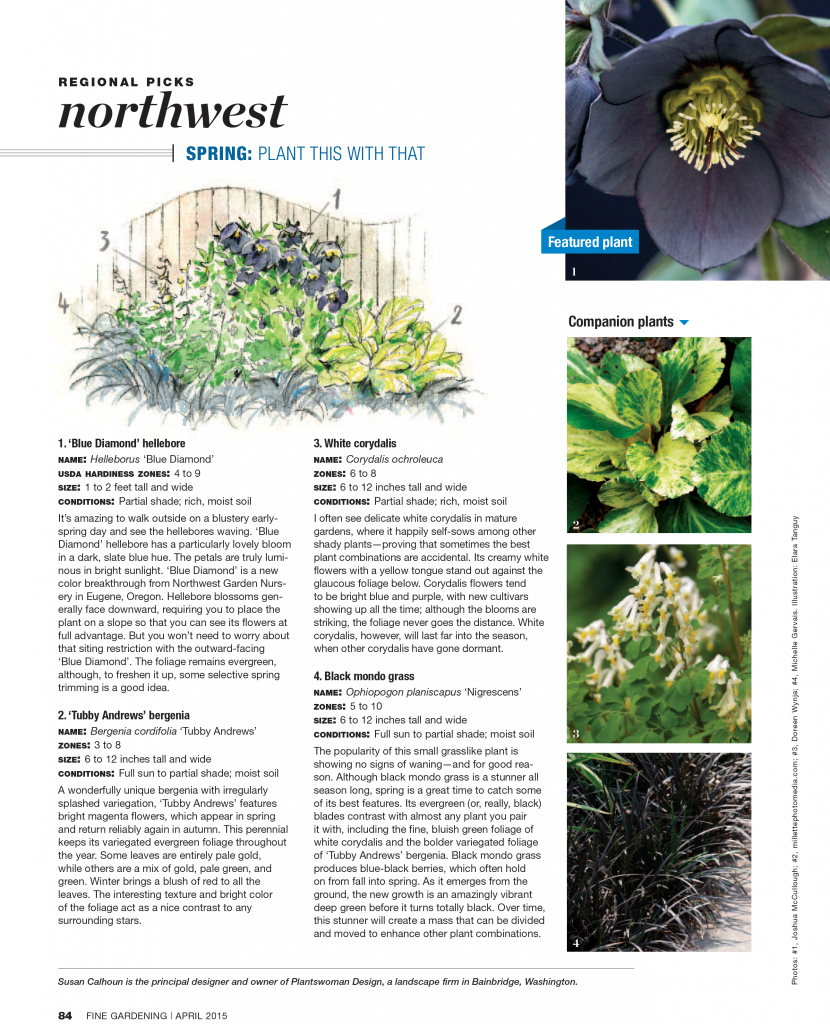
The folks from Fine Gardening will be at the Northwest Flower and Garden Show again this year. They are presenting talks on Wednesday and Thursday and have the only booth that is downstairs near the seminars. So, make time to go down and visit with them. They may have a fun goodie for you to take home.
I will be attending the show Wednesday and Thursday so if you are around those days and want to connect tweet me @susan_PWD.
Remember the seminars are free with your ticket and there are multi-day tickets to help defray some of the cost.
See you at the show!
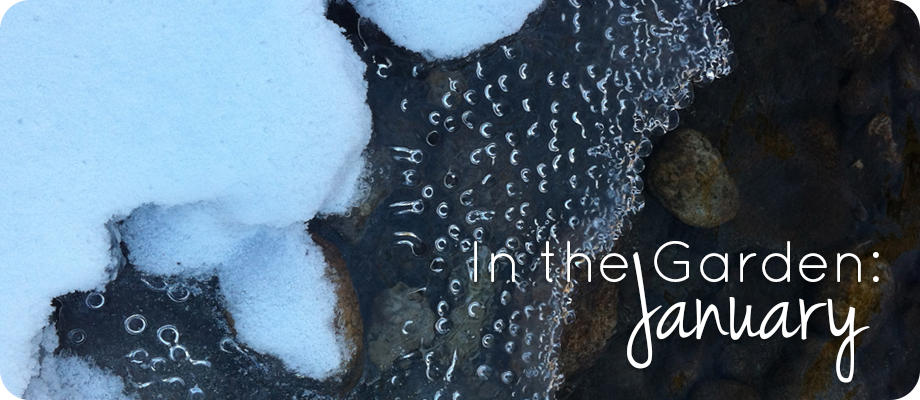
by Susan | Jan 30, 2015 | gardening
It is fun to sit and contemplate the planning of a garden for the coming year. Many times we are anxious to get out and get going,which is great because there are a few things that need to be done while plants are still dormant. Here is the short list of things to be done in the garden right now. Of course I live in the PNW where the ground is not covered with snow but many of these things can be done weather permitting. They should be done before ‘bud break’ (when color shows on buds).
Here’s what you can be doing in the garden right now…
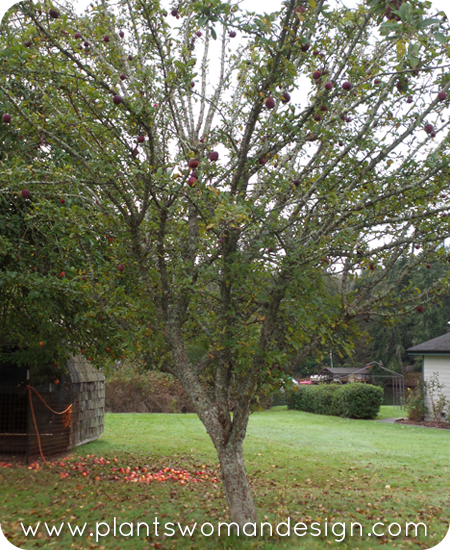 PRUNING FRUIT TREES
PRUNING FRUIT TREES
Now is a great time to check out the structure and get rid of waterspouts and crossing branches. I prune all fruit trees now with the exception of cherry and apricot trees (prunus species). These trees are usually pruned in the summer after fruiting because they are more susceptible to cankers and infection in the winter. Great advice on pruning fruit trees is available from RHS Gardening book “Pruning and Training”. In fact this book is great for pruning almost every shrub I have ever encountered. Take a look at our Fear of Gardening post for more information on pruning.
SPRAYING FRUIT TREES
This is also the time to spray horticultural oil on fruit trees. In Washington state we have a problem with apple codling moth. This pest is prevalent throughout the state because of the massive amounts of old abandoned apple trees and lack of control. Even if you don’t eat your apples you can still help with the control of these unwanted pests. Neem Oil is a naturally occurring pesticide that can help with control. This non-toxic oil helps to kill insects that are overwintering on fruit trees. Other things can be used at different times in the year but now is the time to spray with Neem Oil.
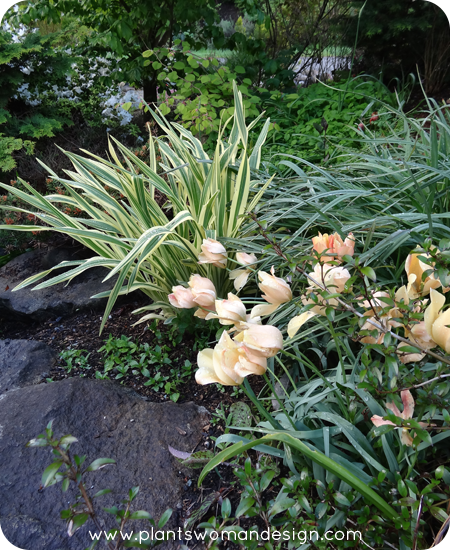 GARDEN TIDY
GARDEN TIDY
Cutting back grasses and cleaning up grounds is a good task for this month. Clean up and mulching now will help with weed control later in the year. I leave a pile of the dried grasses out of the compost heap for birds to use for fodder and nesting.
I also cut back the leaves from my hellebores and my epimediums right now. The sight of the blooms without the messy leaves has more drama than the blooms through the winter damaged leaves.
Check for insect or pest damage. I noticed that my crocus were being eaten. It is too early for slugs and snails so I suspect the rabbits that my neighbor ‘loves’ are to blame. I placed an inverted plant tray over the top of them so they have protection from munching. I will eventually have to add another couple to the stack so that as the leaves and blossoms come out they still have protection.
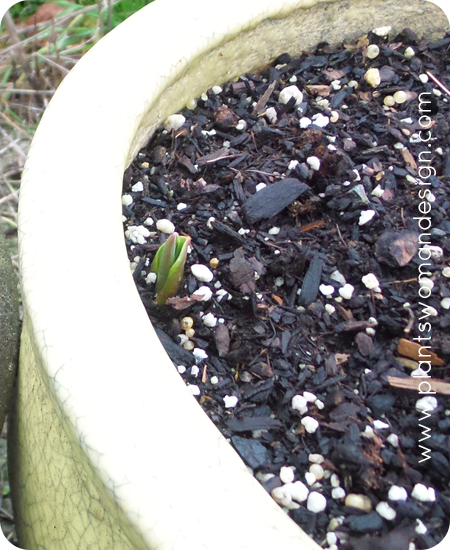 FORCED WINTER BULBS
FORCED WINTER BULBS
I have several pots that I put bulbs in last fall that have been sitting outside ‘chilling’. Now is the time to bring those into a warmer place if you want them to bloom early. You can bring them into the greenhouse or sunny room. The warmth and the light will give them the illusion of spring and bring them up early.
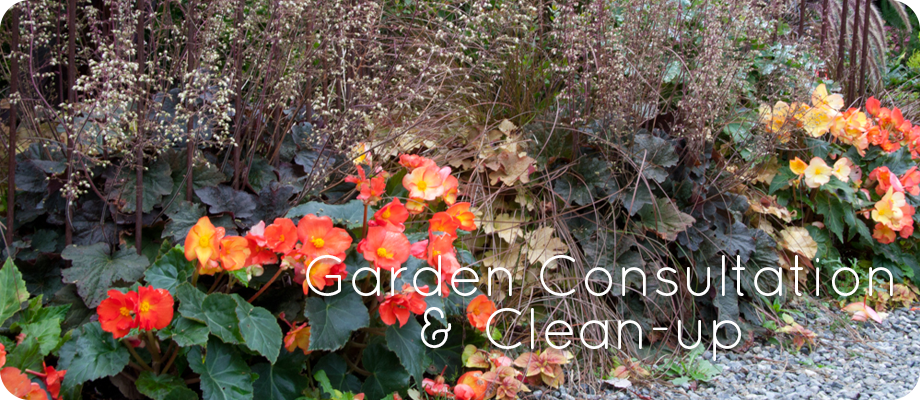 Need help? Right now you can get $25 off a garden consultation or clean up service with Plantswoman Design when you mention this post. We know some of our blog followers aren’t in our neighborhood but that’s okay! We can meet over the phone and I can answer your questions, help you make a plan for spring and if necessary we can set up a video call. Email us at info[at]plantswomandesign[dot]com or call us at 206-842-2453.
Need help? Right now you can get $25 off a garden consultation or clean up service with Plantswoman Design when you mention this post. We know some of our blog followers aren’t in our neighborhood but that’s okay! We can meet over the phone and I can answer your questions, help you make a plan for spring and if necessary we can set up a video call. Email us at info[at]plantswomandesign[dot]com or call us at 206-842-2453.
Information in this post originally appeared in the Plantswoman Design monthly newsletter. Want these great tips and information delivered to you monthly? Just put your email below and you will be added to the list! (please note this list is different from subscribing to the blog)
[mc4wp_form]
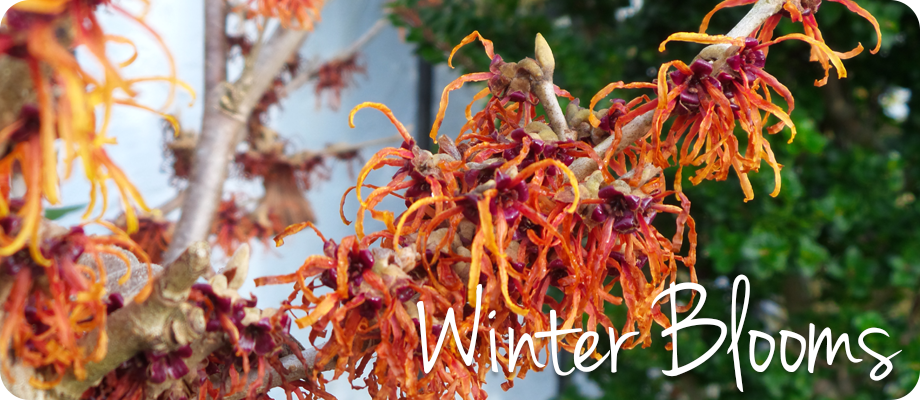
by Susan | Jan 23, 2015 | gardening, plants
It is cold and clear this morning. As you can see I was out in the beautiful morning. Even as cold as it is there are things to see in the garden. These tough plants will bloom despite the weather. The welcome promise of spring in swelling buds and the color of blossoms in bloom get me excited about the end of winter.
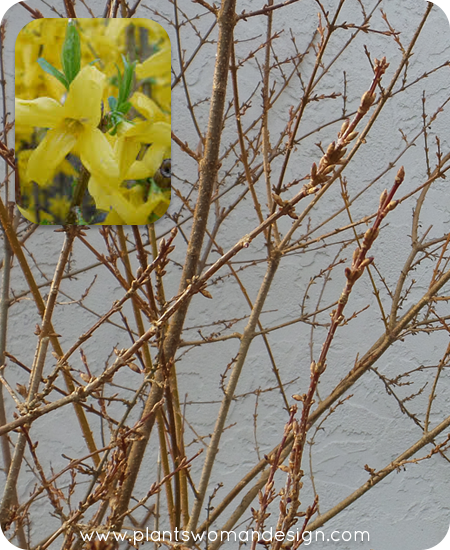
Forsythia X intermedia
This Forsythia was pre-existing on my property. I’m not sure of the variety but it is probably common Forsythia X intermedia, easy to grow and very yellow. I remember my mom bringing the twigs indoors and forcing the blooms in the dead of winter. It is a member a of the Oleaceae family and has light green leaves that appear after flowering. This is one plant like willow that will root in water if left after the blooms fade.
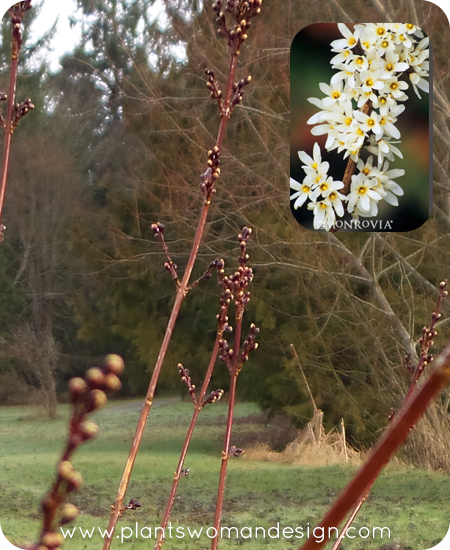
White forsythia (Abeliophyllum distichum)
This deciduous shrub is related to the forsythia, but differs in that it has white flowers that open in early spring before true forsythia. It is also a member of the olive family (Oleaceae). In early spring, before the new leaves form, purplish buds all along the grey naked branches open into small white four-petal, almond-scented flowers with yellow stamens. After flowering, green, glossy abelia-like leaves appear.
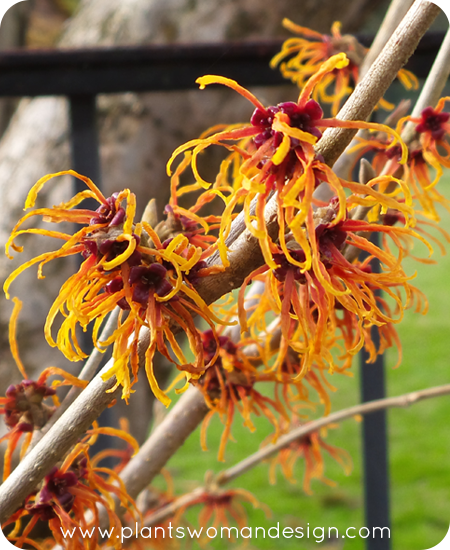
Hamamelis Jelena
Of course anyone that knows me knows I love orange. This is Hamamelis Jelena, a wonderful witchhazel that loves to bloom now with its coppery orange flowers lighting up the winter landscape. The bare branches have a sculptural quality that is a treat before flowering. The leaves come out after flowering and are wonderful ovals with deep ribs. The fall color is simply amazing too. It is hard to beat this plant for year round interest. It is one of those amazing ‘earn its place in the garden’ plants.
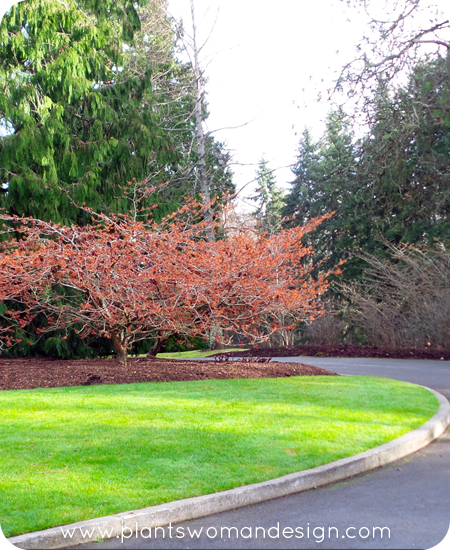
Hamamelis Diana
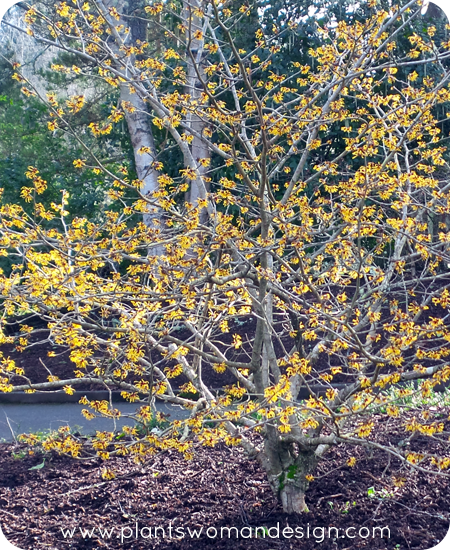
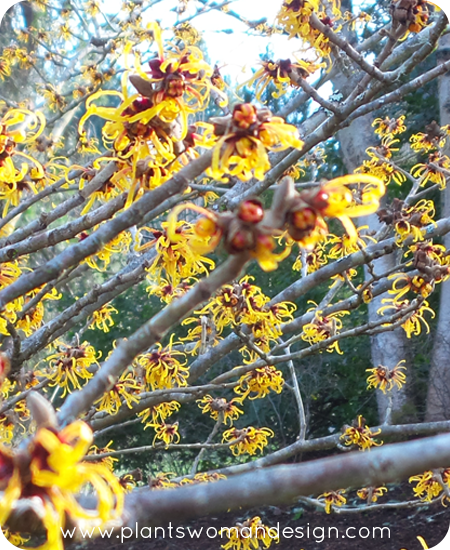 possibly Arnolds Promise
possibly Arnolds Promise
I live close to the Bloedel Reserve which is a fabulous garden on Bainbridge Island. These two pictures are from the front entry. The striking Hamamelis in both the Orange (Hamamelis Diana) and Yellow (possibly Arnolds Promise) colors make a beautiful entry point. Remember from a design point of view these do earn their space in the garden. There are several varieties available including yellow, orange and red flowers, some are intensely fragrant. I did stumble across a Hamamelis x intermedia ‘Feuerzauber’ (Fire Charm) at Valley Nursery today. It somehow found a place in my car and will soon find a place in my new garden.
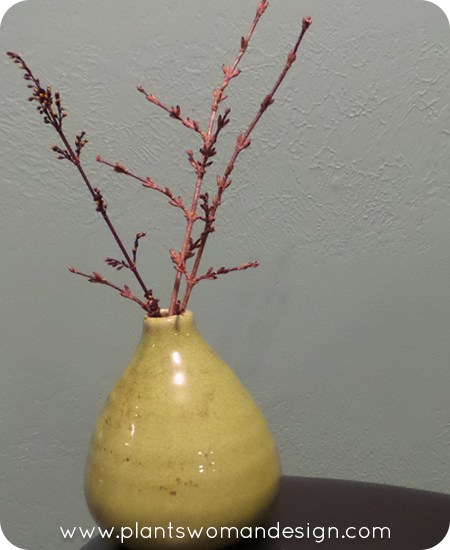 And last but not least here is a picture of the forsythia and abelliophylum in the process of forcing on my desk. I recently picked up some purple tulips and will pull some more forsythia from the garden to force together. The yellow and purple will make a stunning combination.
And last but not least here is a picture of the forsythia and abelliophylum in the process of forcing on my desk. I recently picked up some purple tulips and will pull some more forsythia from the garden to force together. The yellow and purple will make a stunning combination.
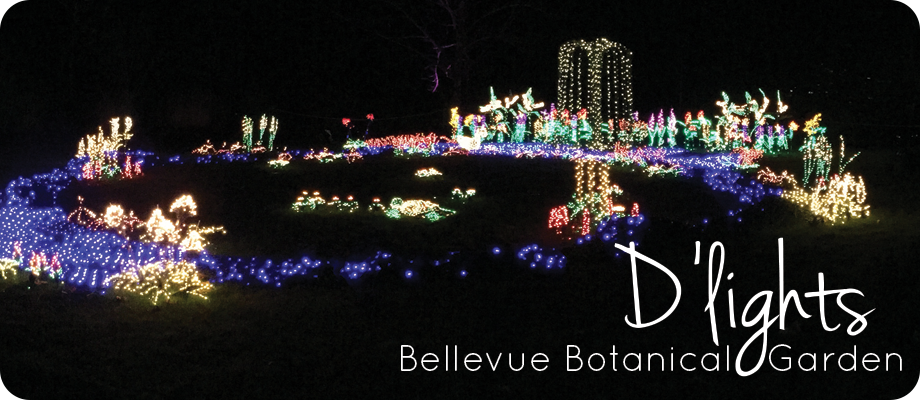
by Susan | Dec 30, 2014 | garden travel
With the family in town we headed over to the Bellevue Botanical Garden’s annual Christmas light display D’Lights. The lights were really quite impressive with many critters and fun things to spot. There is still time to go see the lights until January 3rd, 4:30-9:30pm. Here’s a little peek from our visit! Let me know if you go and what your favorites were.
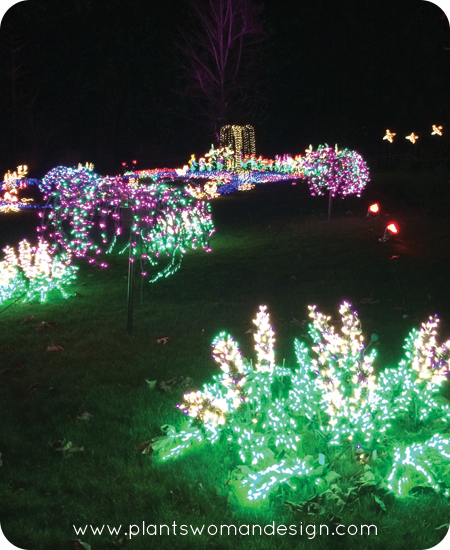
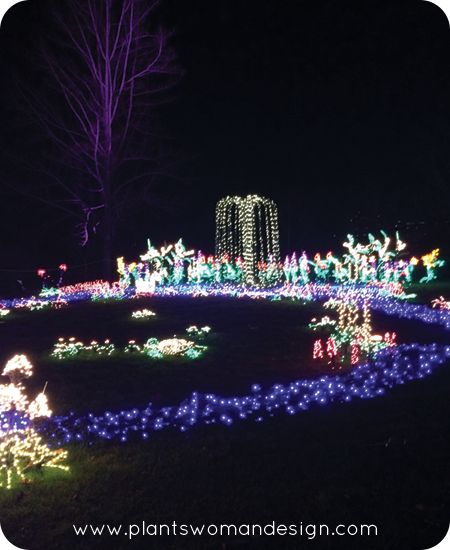
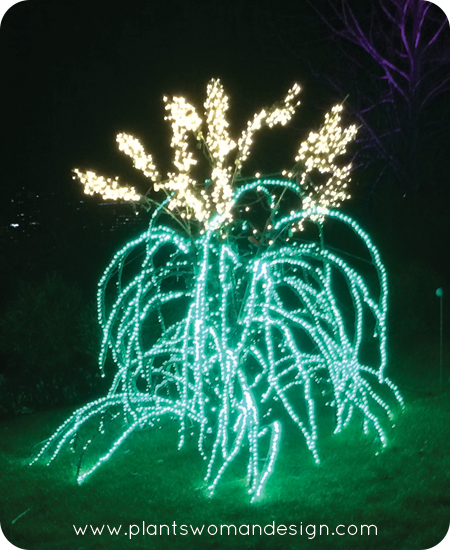


 This is the Crown Bee Kit I purchased. The bees come separate so you can get more If needed. I had a hard time deciding where to put the nesting box. It needed to be where the sun would hit it early in the day to warm them, not near predators (birds mostly), and within 300 feet of a mud/water source. Wanting to see them in action I placed it on a post at eye level next to my vegetable garden plot behind the green house. Mason bees need a ready food source (something blooming) when they emerge. The espaliered fruit trees are almost ready to bloom so they will be available for early food for the bees along with the Forsythia, hellebores, and Indian plum (oemleria cerasiformis) blooming now.
This is the Crown Bee Kit I purchased. The bees come separate so you can get more If needed. I had a hard time deciding where to put the nesting box. It needed to be where the sun would hit it early in the day to warm them, not near predators (birds mostly), and within 300 feet of a mud/water source. Wanting to see them in action I placed it on a post at eye level next to my vegetable garden plot behind the green house. Mason bees need a ready food source (something blooming) when they emerge. The espaliered fruit trees are almost ready to bloom so they will be available for early food for the bees along with the Forsythia, hellebores, and Indian plum (oemleria cerasiformis) blooming now. Following the directions, I placed the lid on the post and used screws to attach it. I left the top screw out a little and tightened the bottom one so there was a little slant. This helps to protect the home from rain. However, the downward slant can’t be too great or the block of nesting holes will fall out.When the tube was attached , I took off the clear plastic cover, slid the block inside and put the bee attractant, which helps the bees find their home when they first emerge, on the top.
Following the directions, I placed the lid on the post and used screws to attach it. I left the top screw out a little and tightened the bottom one so there was a little slant. This helps to protect the home from rain. However, the downward slant can’t be too great or the block of nesting holes will fall out.When the tube was attached , I took off the clear plastic cover, slid the block inside and put the bee attractant, which helps the bees find their home when they first emerge, on the top. When I opened the box of bees, it was so exciting to see that a couple of the bees had already emerged from their cocoon! I could see them sleeping in there.
When I opened the box of bees, it was so exciting to see that a couple of the bees had already emerged from their cocoon! I could see them sleeping in there. I placed the box near the opening so as they emerged they would see the nesting box. When I checked the next day I saw two bees flying around the box.
I placed the box near the opening so as they emerged they would see the nesting box. When I checked the next day I saw two bees flying around the box. 






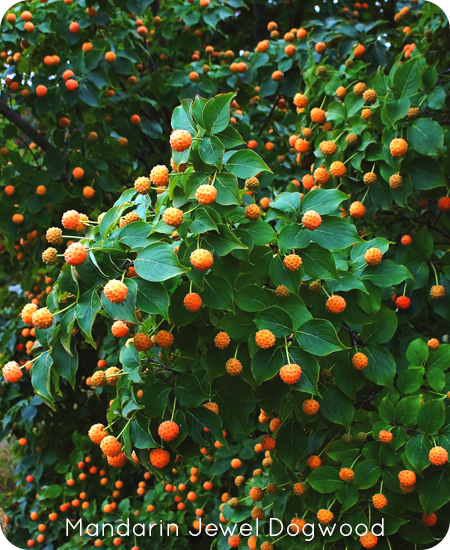





























 possibly Arnolds Promise
possibly Arnolds Promise




